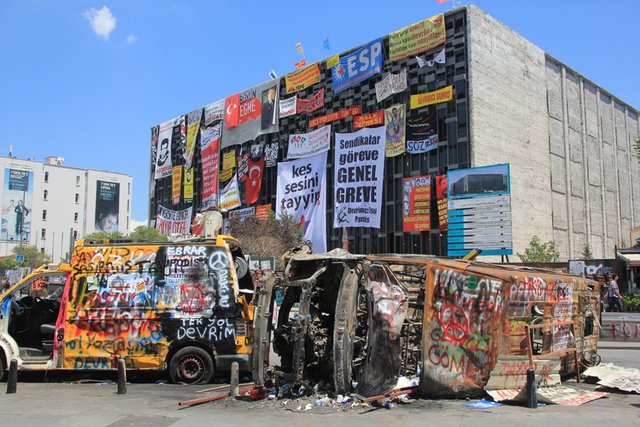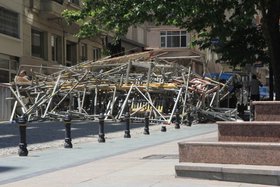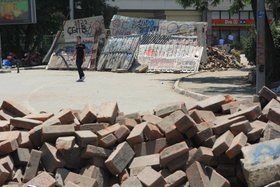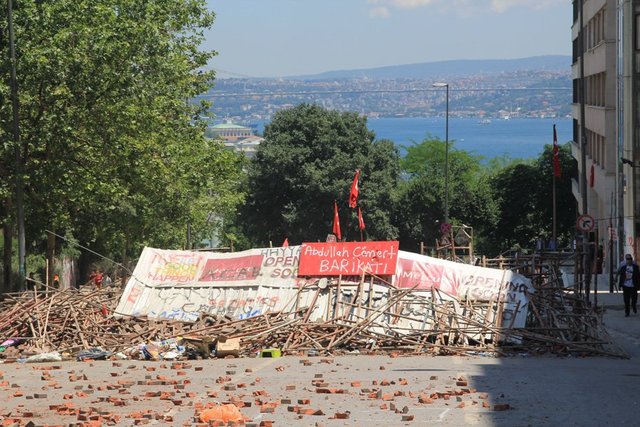Essays
To the Barricades
Gezi Resistance, Public Space and the Counter-monumental
Early morning on the 28th May 2013, the tents at Gezi Park awoke to the beloved song by Istanbul's anarcho-communist, klezmer-ska-Balkan-reggae-inspired band Bandista, a boisterous remake of an anarchist anthem from the Spanish Civil War, 'A Las Barricadas':
Haydi barikata (To the barricades)
Haydi barikata (To the barricades)
Ekmek adalet ve özgürlük için! (For bread, freedom and justice!)
Among those sleeping in the tents was a disgruntled member of the band, who later complained to the wake-up call team: 'Ok, the analogy is admittedly flawed, but imagine hitting Michelangelo on the head with his statue of David to wake him up?' There were no barricades to go to for bread, freedom or justice at this stage. The camp at Gezi Park was in its first morning, and the struggle for the conservation of the park and its trees felt like yet another lost battle in the relentless onslaught of neoliberal annexation, facilitated by a governmental authority ready to unleash its means of violence against any opposition, no matter how small. At this stage, certainly no one could imagine that within a matter of few days there would indeed be barricades to go to, not just the usual police barricades but homemade ones by the resistance. In fact there would be many to choose from, delimiting an enormous state-free zone in the very heart of the city.
It has become proverbial: in the middle of the night on 27th May, bulldozers began demolishing one side of Gezi Park in a blatant breach of existing planning permissions. Concerned people rushed to the site, a few dozen stayed over. The next day, on 28th May, the numbers of those keeping watch over the park did not quite reach 100, but they withstood attacks of the police who were sent over to secure the unlawful demolition by means of tear gas and brute force. This is when the woman in red photo was taken – now an iconic image crystallizing the absurdity of quotidian, undue police violence against the average citizen.
In the afternoon, the arrival of MP Sırrı Süreyya Önder, who demanded to see the planning permissions, brought the demolition to a temporary halt. That night there were about 40 tents in the park. The following day, 29th May, Prime Minister Tayyip Erdoğan addressed those keeping watch over the park, saying, 'Do what you like. We've made our decision and we'll execute it', referring to the plans for demolishing the park to make way for a shopping mall fronted with a façade of the 18th century Ottoman barracks once located there. Following Erdoğan's defiant speech, 150 people stayed over at the park. The next morning, at 5am on 30th May, the police attacked the camp with tear gas, burned the tents down, and made way for the bulldozers to continue demolishing the park for a few hours, until MP Önder came at 7:50am and stood in front of the machines again.
That night, thousands came to the park and hundreds stayed over, only to be attacked once more at 5am on 31st May by riot police, this time with water cannons in addition to the tear gas. As the street fighting went on during the day, an administrative court ruled on the suspension of the demolition, siding with the protesters. Following a call for a demonstration in the evening at Gezi Park, tens of thousands of people attempted to get there, but the police were intent on not allowing assembly, suffocating Taksim Square and the surrounding neighbourhoods in a cloud of tear gas for the entire evening and straight through the night.
The outrage against police violence and this brutal manner of governance was amplified by the total disjuncture between what was being reported on in social media, and the lack of any mention of ongoing police violence on almost all Turkey's TV channels, the great majority of which are private and have been bribed or forced into obedience by the government over the last several years. People, regular people, from all over the city, and indeed, all over the country, had had enough. They just walked out. An endless stream of bodies kept coming at the police with bare hands and chants.[1] When those at the frontlines were pushed back by force, those at the back took their place. Eventually Taksim Square was reclaimed the next day, on the afternoon of 1st June: the people forced the police to withdraw and leave the square, and the park and an enormous surrounding area became entirely free from state presence for ten days.
This zone became the site of an unprecedented eruption of speech, contagion of laughter, and outbursts of wit. One quip that circulated from early on was that the 13th Istanbul Biennial scheduled for this September should be cancelled, since it already happened. This was particularly pertinent, as the conceptual framework of the biennial had been announced earlier this year as 'the idea of public space as a political forum'.[2] Under the title 'Mommy, am I a barbarian?' borrowed from the beloved Turkish poet Lâle Müldür, the curatorial programme of the biennial was designed to question contemporary forms of democratic representation, challenge the exclusionary practices of urban transformation, and explore the role of the art industry in such practices. The critical edge of the conceptual framework must have been interpreted either as insufficient, disingenuous, or as a strategy of autoimmunization by the critics of the biennial, who have been staging a series of protests at the pre-biennial events in an effort to expose the affiliations of the biennial with capital groups that drive Istanbul's urban transformation. One banner unfurled at one of these events, read 'Mommy, am I human?' It later found its way to the occupation at Gezi Park.
Indeed the conceptual and aesthetic effect of the physical re-appropriation of the city centre has arguably surpassed that of any biennial or other art event Istanbul has ever hosted. The ruins of 'vandalized' public busses, media vans and police cars stood, some upside-down, as monuments to the unthinkable. The graffiti that filled the walls disarmed the passersby with humour and poetry. Performance pieces became a thing of the ordinary: people reading books in front of police shields, a whirling dervish in the middle of Taksim square donning a gasmask, and later, the famous standing people. The barricades themselves were marvellous floating installations that changed every single day, collectively remade, consolidated, renamed, and beautified. One morning, the occupation awoke to the smiling bricks of one barricade. Another morning, the bricks of another barricade had been ordered into six perfect 1.5m x 1.5m x 1.5m cube structures. One barricade featured the frame of a re-appropriated billboard as a pedestrian gate; another was 'played' by drummers for an occupation music video. Their sight made one giddy: they were impossibly strong and obviously vulnerable at once.
From the first day of the occupation onwards, the barricades were a key point of debate at the coordination meetings held by the umbrella organization 'Taksim Solidarity'. Some felt that the paralysation of everyday life affected by the barricades in a zone ten times larger than Gezi Park itself delegitimized the occupation at the park and its demands. Others thought the barricades endangered the occupation, presenting the authorities with an excuse to intervene with force, as if any excuse were necessary. Yet others were worried about the undercover police activity at the barricades, provoking excitable youth into conflict with the uniformed police and then detaining them.
The barricades did not necessarily make life at the park easier: for the first several nights after Taksim Square was secured, the park was again enshrouded in tear gas wafting up from the barricades where avoidable clashes were taking place, making the park an unsafe space for children and the elderly. There were technical objections too: some of the barricades had to be removed and people argued, because they were blocking access to hospitals. (Then again, during the heated days of the resistance, the police had used ambulances to transport gas canisters.) But throughout the occupation, the feeling in the park at daybreak, when it was at its least populated and most exhausted, was one of gratitude for the barricades and those who guarded them. The knowledge that they were there gave a fragile but significant sense of security after the tens of thousands who frequented the park and Taksim Square into the late hours of the night had gone home, to come back again the next day. The uncanniness of the liminal hours of dawn was partially alleviated by these liminal installations and those who made a home in and around them.
People who built and then kept guard at the barricades were mainly youth in their teens or early twenties, some of them members of radical left factions, but the majority not. This was an odd amalgam of the dispossessed from the surrounding neighbourhoods and middle and upper class but otherwise disenfranchized kids. The barricades provided them a point of participation in the resistance, a space of articulation at the threshold of the polity-in-making, a marginal incorporation for sure, but one that had its own dignity. When the authorities attempted to negotiate with the resistance, suggesting that the park occupation can remain if the barricades were removed, a well-spoken habitué of the barricades came to the Taksim Solidarity meeting to say: 'If you want us to take down the barricades, we can, and it'll take us half a day to put them back up if need be'. This endless possibility of doing and undoing was precisely the spirit of the barricades. They were transient, vulnerable, destroyable, re-creatable, and as such, they were inextinguishable counter-monuments.
The counter-monumental is in fact an apt term for what was taking place in the space encircled by the barricades during those 10 state-free days: a re-appropriation and dethroning of the monumental, both aesthetically and politically. The symbolic weight of Taksim Square, the 'emblematic site in urban public consciousness for the enactment, production, and regeneration of the political',[3] is propped up by a number of monumental structures, most conspicuously, the Republic Monument located just off the centre of the square and the landmark building, Atatürk Cultural Centre (AKM). Both were covered with banners and flags during the occupation, the sight of which prompted a double take each time: Is this really happening?
Monumental space is, in Henri Lefebvre's words, 'determined by what may take place there, and consequently by what may not take place there (prescribed/proscribed, scene/obscene)'.[4] There was something paradigm-shifting about seeing people on the rooftop of AKM, and then seeing people sitting, lying or putting tents up on the landscaping around the monument, previously so unimaginable as ground to tread on that it hadn't even required the usual 'do not walk on the grass' signs for people to keep out. Then again, Gezi itself is a monumental park: it is elevated above ground level, and whichever side one enters, one needs to climb stairs to access it - from Taksim Square, it is 19 steps up. Perhaps because of this temple-like and somewhat unwelcoming design, Gezi had been under-utilized compared to other parks such as the well-loved and frequented Abbasağa Park in Beşiktaş and Yoğurtçu Park in Kadıköy (which have now both become sites for nightly public forums since the original occupation at Gezi was forced out).
As sociologist and critical thinker Meltem Ahıska reminds us, monuments are not just symbols of power, they also produce an imagined community by immortalizing the mythical memory of origins of the nation, imposing a closure where there is none, petrifying the living into dead stone. In her words, they 'reify the present as a fulfilled moment of arrival'.[5] The nation-state imaginary imposed by the monumental at Taksim Square is an exclusionary, patriarchal and oppressive one, in line with Turkey's official state ideology. The political symbolism of Taksim Square has rendered it, especially from the 1970s onwards, a key destination for political action and opposition. If we are to understand the spatial dynamic of protest in terms of 'reclaiming the national, local or communal space and its symbolic attributes',[6] almost all protests scheduled around the square in the past decades, especially since the bloody 1st May 1977 demonstration, have been driven by a fantasy of 'taking back Taksim', as if it ever properly belonged to the people. The desire for the symbolic re-appropriation of Taksim Square has been countered by excessive police presence for the last many decades, culminating in the de facto declaration of martial law for this year's 1st May demonstration,[7] and the consequent banning of all political protests on the square and its environs.
In many of its incarnations, the fantasy to take back Taksim Square has been driven by political imaginaries that were also seduced by the monumental. One way in which this found expression during the June occupation was the traditional left parties' unwavering insistence on holding on to their own flags in the square, despite many requests to 'take down the flags, so we could see one another's faces'. But what defined the spirit of the occupation was precisely a move beyond monumental politics. As reported in many articles that have been written about the Gezi Resistance, the state-free zone became a site for a politics of contact between previously un-alignable groups and organisations. The law of this self-organized space was civility, solidarity and explosive humour - the latter shattering the brittle categorizations that separate and regulate the body politic. This constituted the beginnings of an unravelling of rooted prejudices and worn out enmities, a re-articulation of constituent power in all its diversity, and the emergence of new subjectivities as visible and viable beyond the petrified subject of the official nation-state ideology. This process might well be described as the de-monumentalization of political imaginaries.
Most of the barricades were removed on 11th June. The state repossessed Taksim Square and the roads leading to it. A few days later, on 15th June, the occupation at Gezi Park was also forced out. Oppressively large Turkish flags and a giant portrait of Atatürk have replaced the resistance banners on AKM, and the Republic Monument has been returned to its previous sterile state. However, the resistance has dispersed rather than dissipated, as local parks across the city continue to host general assemblies nightly, and the streets of the city centre have become stage to demonstrations and creative actions several times a week. Though it is still too early to gauge the concrete political victories of the Gezi resistance, a particular dynamic has been unleashed into the public sphere, promising to transform it for good. This could be identified as the political counterpart of what physically took place in the state-free zone during those ten days: the subversion of the monumental, and the ceaseless construction of counter-monuments. Yes, barricades can be built, destroyed, rebuilt and destroyed again. But what cannot be undone is the de-monumentalization of the political itself.
[1] According to the official figures announced by the Ministry of Interior on 22 June 2.5 million people took to the streets for Gezi protests in 79 cities, out of a total of 81. See: '2.5 Milyon İnsan 79 İlde Sokağa İndi', Milliyet, 23 June 2013 http://gundem.milliyet.com.tr/2-5-milyon-insan-79-ilde-sokaga/gundem/detay/1726600/default.htm.
[2] 'The Conceptual Framework of the Biennial was Announced,' iKSV Bienal website http://bienal.iksv.org/en/archive/newsarchive/p/1/622.
[3] Yael Navaro-Yashin, Faces of The State: Secularism and Public Life in Turkey (Princeton: Princeton University Press, 2002), 1.
[4] Henri Lefebvre, The Production of Space, trans. Donald Nicholson-Smith (Oxford: Blackwell, 1991), 224.
[5] Meltem Ahıska, 'Monsters that Remember: Tracing the Story of the Workers' Monument in Tophane, Istanbul,' Red Thread 3 (2011): 1-23.
[6] Ayşegül Baykan and Tali Hatuka, 'Politics and Culture in the Making of Public Space: Taksim Square, 1st May 1977, Istanbul,' Planning Perspectives 25.1 (2010): 55.
[7] 'May Day in Istanbul: 72 Detained, Scores Injured,' Bianet, 2 May 2013 http://www.bianet.org/english/labor/146303-may-day-in-istanbul-72-detained-scores-injured.









